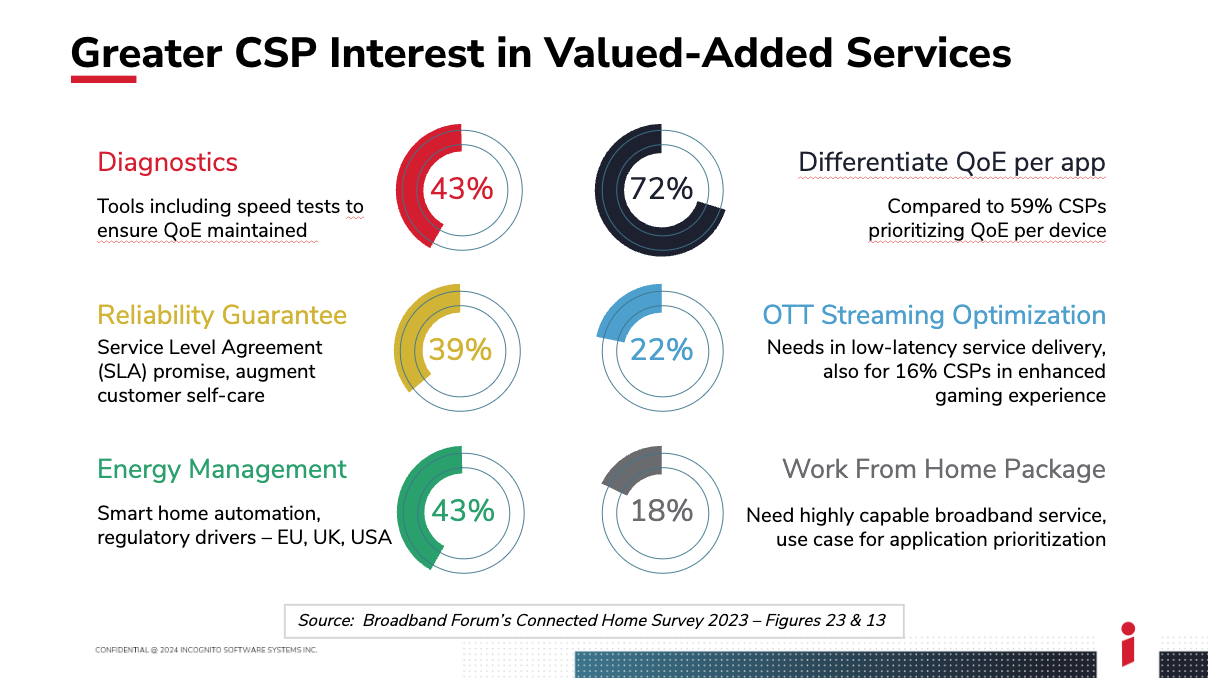As emerging technologies spark a fresh wave of innovation within the broadband industry, the dynamics of the connected home experience have entered a new era. In the recent webinar hosted by the Broadband Forum, The Future of the Connected Home, I had the privilege of participating in a presentation that explored how service providers can not only meet but exceed customer expectations in this connected age. Armed with insights from the Omdia Connected Home report and real-world Incognito customer deployments, the discussion centered around tactics to elevate the subscriber experience with innovative services, energy management, and analytics.
During the webinar, I examined global operator needs and challenges and discussed how service providers can enhance customer satisfaction using a TR-369 User Services Platform (USP)-driven architectural strategy.
Amidst the seasonal comings and goings of the cold and flu, my home has witnessed a surge in network activities, mostly attributed to my twin 7-year-olds. Whether it's online classes, video streaming, or virtual dance sessions, our home network has been under constant strain. Increased bandwidth usage and latency-sensitive services raised concerns about network performance during important work meetings and leisure activities, like watching our favourite NHL ice hockey team in the lead-up to the playoffs, and faced with IPTV video issues and constant device reboots – that should not be my problem to address – I was getting frustrated! I immediately contacted my service provider, expressing dissatisfaction with the promised premium work-from-home (WFH) package.
Strategic Pillars for Enhancing Quality of Experience
This personal anecdote resonates profoundly with the global narrative highlighted in the 2023 Omdia report. The report emphasized the importance of differentiated services, including traffic and application prioritization for various use cases, such as cloud gaming and remote work, to ensure a high-quality home network experience for subscribers. Service orchestration emerges as a cost-effective solution to foster seamless connectivity, facilitating the end-to-end lifecycle management of services, devices, and applications.
In the webinar, I also explored strategies for operators to monetize the market trends identified in the report and increase customer satisfaction by walking through a customer case study of an Incognito USP deployment.

A question posed by the audience at the end of the session really stood out to me—they asked where the best place to start improving the quality of experience is. Other panellists thought to jump right to home Wi-Fi optimization, but at Incognito, we take a different approach.
First, you need to understand the data and quantify the problem, along with where and why it is occurring. Is it the access network? The CPE, residential gateway, or your ONT/ONU? Or is it within the home connectivity? This is where diagnostics that span those components of the network are crucial to provide that complete picture. Other parts of your analysis before jumping in should include:
- Are you missing SLAs across B2B, SMB, or SOHO services?
- Speed test results – what insights do those yield?
- Customer churn – why are customers leaving, is it network reliability or performance?
- Within the access network, is there congestion or service degradation? What are the traffic patterns?
Without understanding where the impacts to service quality are taking place, this turns into a game of whack-a-mole. At Incognito, not only do our solutions provide the network data collection capabilities to understand the performance of access, device, and home networks, but also the automation to fix those issues and deliver a great service experience to your customers.
Proactive Diagnostics and Telemetry
Diagnostics play a crucial role in identifying and resolving issues, with real-time telemetry enabling proactive measures to maintain quality of experience. Hybrid architectures combining cloud and customer premises equipment (CPE) deployments offer scalability and responsiveness while addressing energy management and sustainability concerns.
The report underscores the growing adoption of USP architectures among service providers, enabling them to deliver superior connected home experiences. Incognito's expertise in TR-369 USP deployment and holistic process automation can empower operators to stay competitive and boost revenues (ARPU).
The Path Ahead
In summary, Incognito's perspective on the Omdia report webinar highlights key strategies for service providers, including prioritizing applications, leveraging diagnostics, and embracing USP architectures. For further insights on delivering value-added services and ensuring exceptional quality of experience, service providers can explore solutions like Incognito's Digital Experience (DX) Solution, which offers service orchestration and container technology with TR-369 USP support. Contact our solutions team today to get started with USP.
Watch the on-demand version of the webinar recording:



Submit a Comment